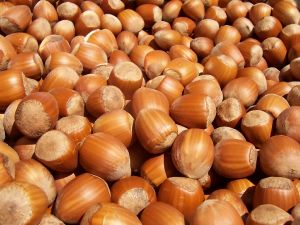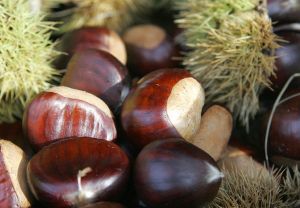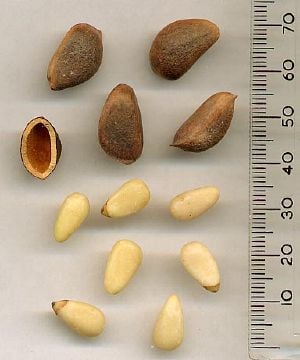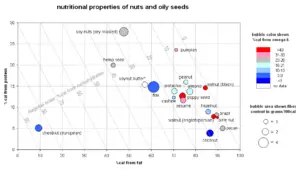Nut
A nut can be either a seed or a fruit.
Botanical definitions
A nut in botany is a simple dry fruit with one seed (rarely two) in which the ovary wall becomes very hard (stony or woody) at maturity, and where the seed remains unattached or unfused with the ovary wall. Most nuts come from pistils with inferior ovaries (see flower) and all are indehiscent (not opening at maturity). True nuts are produced, for example, by some plants—families of the order Fagales.
- Order Fagales
- Family Juglandaceae
- Walnut—esp. Persian Walnut (Juglans regia)
- Butternut (Juglans)
- Hickory, Pecan (Carya)
- Wingnut (Pterocarya)
- Family Fagaceae
- Family Betulaceae
Culinary definition and uses
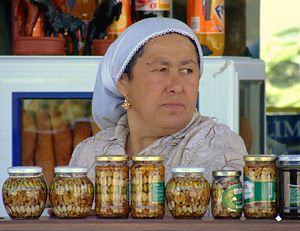
A nut in cuisine is a much less restrictive category than a nut in botany, as the term is applied (or misapplied, depending upon the viewpoint) to many seeds that are not true nuts. Any large, oily kernel found within a shell and used in food may be regarded as a nut. Because nuts generally have a high oil content, they are a highly prized food and energy source. A large number of seeds are edible by humans and used in cooking, eaten raw, sprouted, or roasted as a snack food, or pressed for oil that is used in cookery and cosmetics. Nuts (or seeds generally) are also a significant source of nutrition for wildlife. This is particularly true in temperate climates where animals such as jays and squirrels store acorns and other nuts during the autumn to keep them from starving during the winter and early spring.
Nuts, including both tree nuts and peanuts, are among the most common food allergens.[1]
Some fruits and seeds that are nuts in the culinary sense but not in the botanical sense:
- Almond is the edible seed of a drupe—the leathery "flesh" is removed at harvest.
- Brazil nut is the seed from a capsule.
- Candlenut (used for oil) is a seed.
- Cashew nut is a seed.
- Coconut is a dry, fibrous drupe.
- Horse-chestnut is an inedible capsule.
- Macadamia nut is a creamy white kernel (Macadamia integrifolia).
- Mongongo
- Peanut is a legume and a seed.
- Pine nut is the seed of several species of pine (coniferous trees).
- Pistachio nut is the seed of a thin-shelled drupe.
See also: List of edible seeds
Nutritional benefits
Several epidemiological studies have revealed that people who consume nuts regularly are less likely to suffer from coronary heart disease. Recent clinical trials have found that consumption of various nuts such as almonds and walnuts can lower serum LDL cholesterol concentrations. Although nuts contain various substances thought to possess cardioprotective effects, scientists believe that their fatty acid profile is at least in part responsible for the hypolipidemic response observed in clinical trials.
In addition to possessing cardioprotective effects, nuts generally have a very low glycemic index (GI). Consequently, dietitians frequently recommend nuts be included in diets prescribed for patients with insulin resistance problems such as diabetes mellitus type 2.
One study found that people who eat nuts live two to three years longer than those who do not. However, this may be because people who eat nuts tend to eat less junk food. [2]
Other uses
The "nut" of the horse-chestnut (Aesculus hippocastanum), is also known as a conker. Conkers are inedible, due to the presence of the toxic glucoside aesculin, but are collected and used in an old children's game, also known as conkers, in which a nut is threaded onto a strong cord and then each child attempts to break their opponent's conker by hitting it with their own. A related species, Aesculus californica, was formerly eaten by the Native Americans of California in times of famine. It must be leached to remove the toxic constituents before eating.
Notes
- ↑ Common Food Allergens - The Food Allergy & Anaphylaxis Network. Retrieved October 27, 2007.
- ↑ The Places Where People Live Longest - ABC News. Retrieved October 27, 2007.
ReferencesISBN links support NWE through referral fees
Kellogg, John H. Nuts May Save the Race. The Itinerary of Breakfast. New York: Funk & Wagnalls Company, 1920. p.165–203.
External links
All links retrieved October 27, 2007.
- What is a Nut? by John Sankey
- Black Walnut Crackers by John Sankey
- Nuts - nutra-smart.net
- Micronutrient Information Center - Linus Pauling Institute
- Nuts and their bioactive constituents: effects on serum lipids and other factors that affect disease risk - American Journal of Clinical Nutrition
Credits
New World Encyclopedia writers and editors rewrote and completed the Wikipedia article in accordance with New World Encyclopedia standards. This article abides by terms of the Creative Commons CC-by-sa 3.0 License (CC-by-sa), which may be used and disseminated with proper attribution. Credit is due under the terms of this license that can reference both the New World Encyclopedia contributors and the selfless volunteer contributors of the Wikimedia Foundation. To cite this article click here for a list of acceptable citing formats.The history of earlier contributions by wikipedians is accessible to researchers here:
The history of this article since it was imported to New World Encyclopedia:
Note: Some restrictions may apply to use of individual images which are separately licensed.
